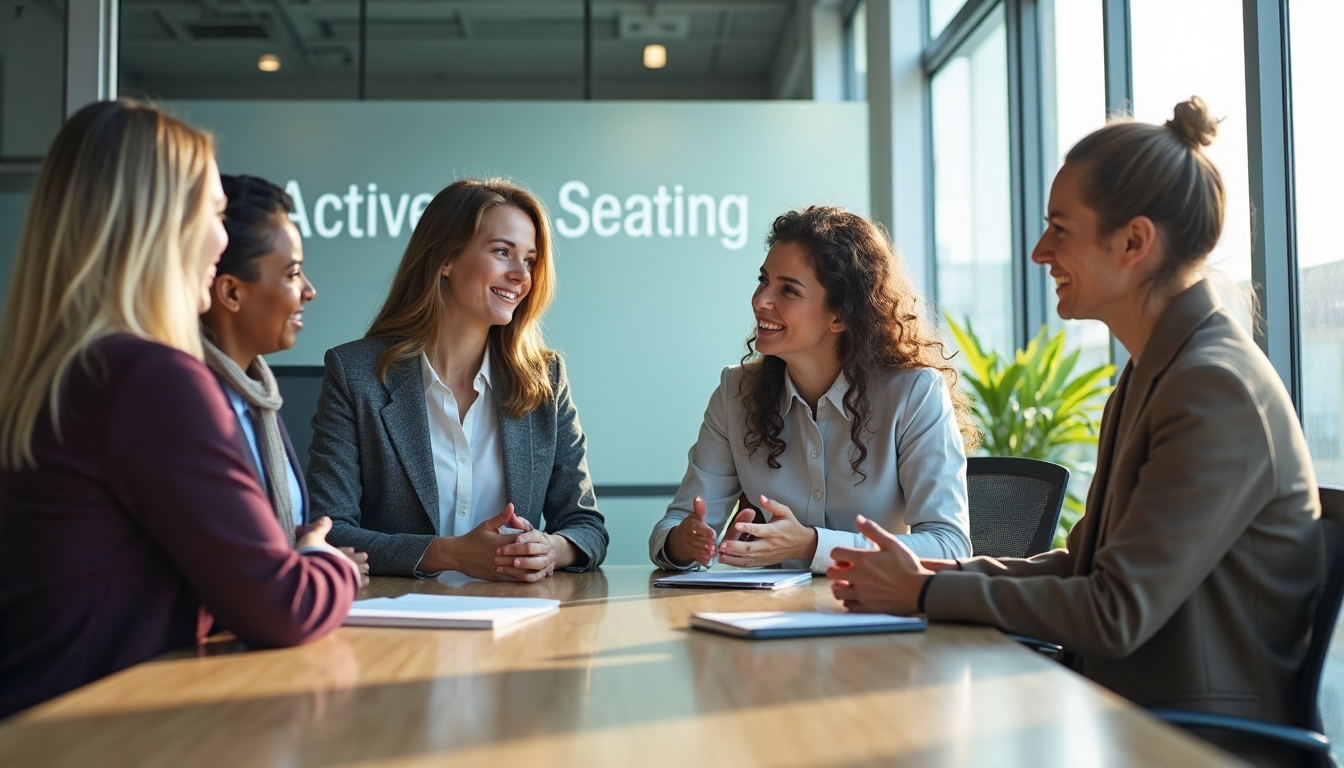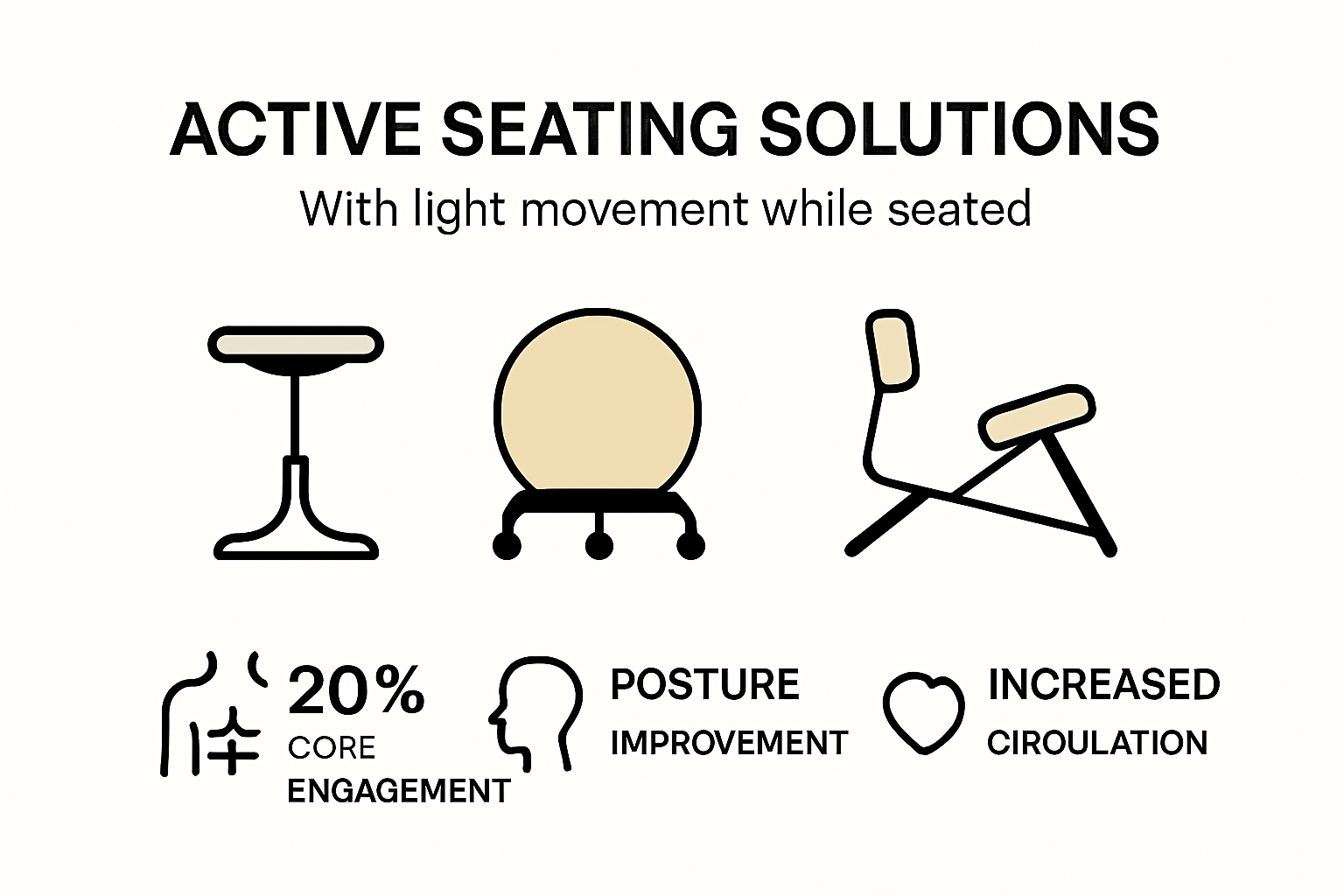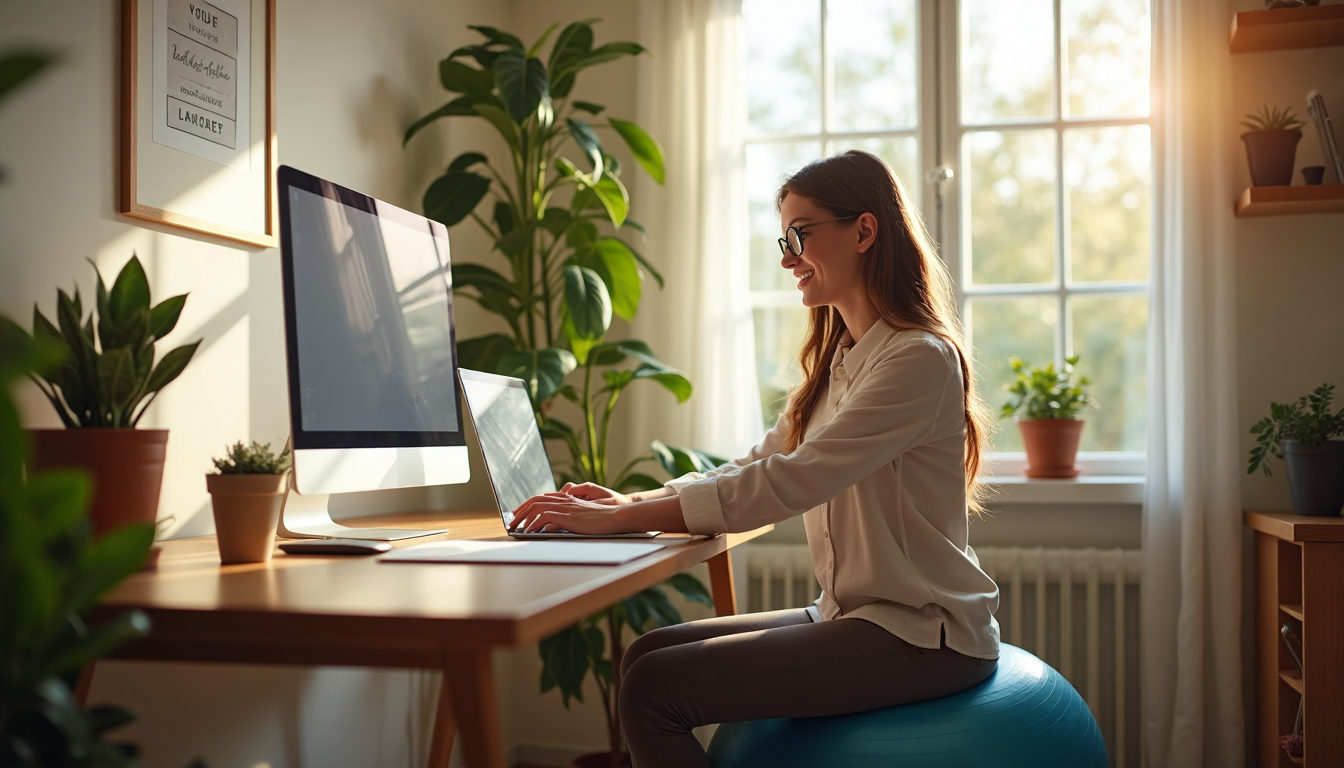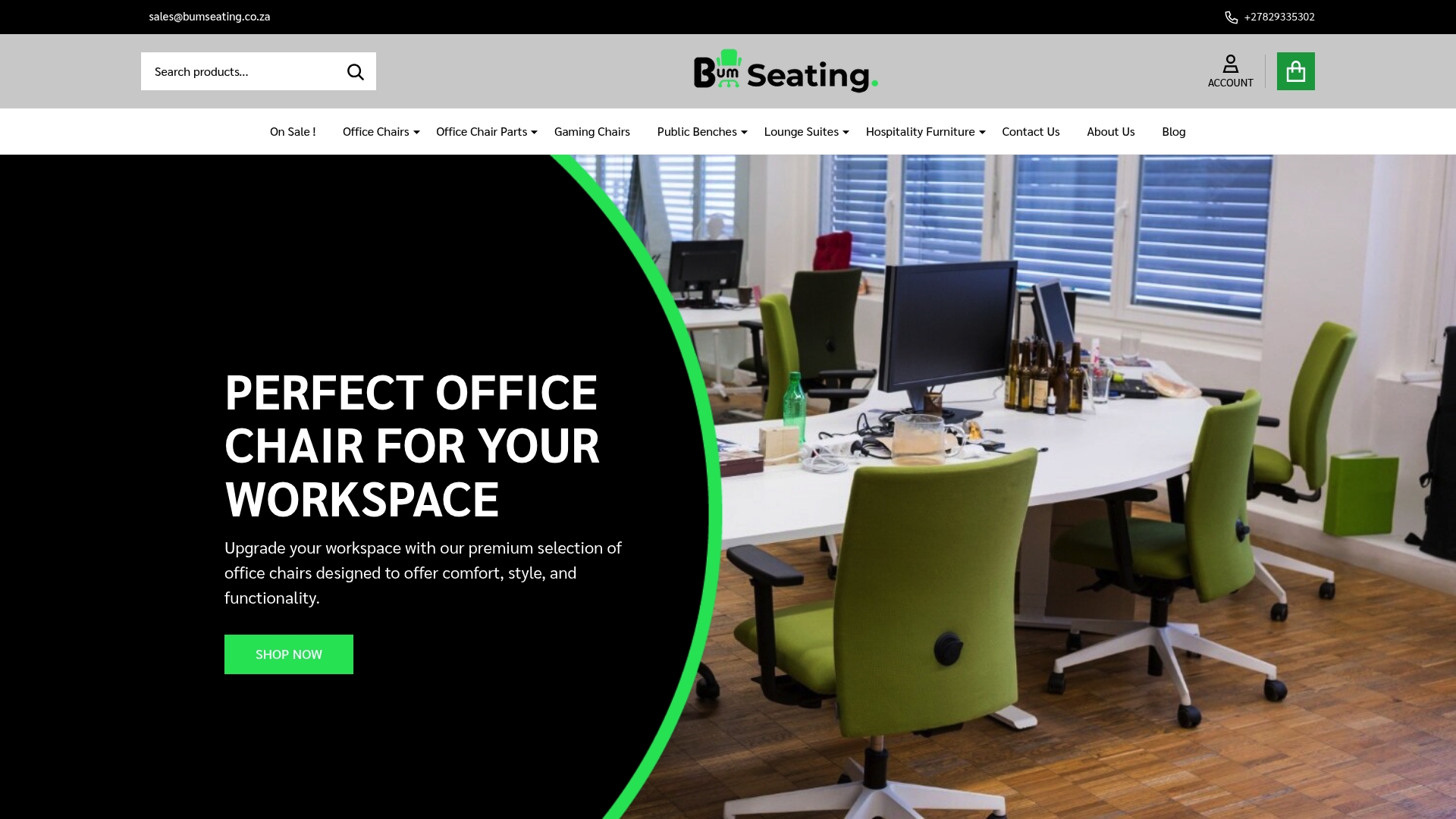Active Seating Solutions for Modern Offices and Homes 2025
7th Jul 2025
Active Seating Solutions for Modern Offices and Homes 2025

Active seating solutions are taking over offices and homes across South Africa, promising a new level of comfort and well-being at your desk. Yet, the real surprise is not just in how they feel under you. Here’s what jumps out — certain alternative active seating options can boost leg muscle activation by up to 40 percent compared to normal chairs. So, if you thought a chair was just for sitting, think again. The future of work means your workspace works just as hard as you do.
Table of Contents
- What Are Active Seating Solutions And Their Benefits
- Key Types Of Active Seating For Office And Home
- How To Select The Best Active Seating For Your Needs
- Top Active Seating Trends In South Africa For 2025
Quick Summary
| Takeaway | Explanation |
|---|---|
| Active Seating Enhances Health and Productivity | Active seating solutions promote better posture, circulation, and core engagement, which can lead to improved cognitive performance and overall wellness. |
| Variety of Active Seating Options Available | There are numerous active seating choices, including ergonomic dynamic chairs, balance ball chairs, kneeling chairs, and perching stools, catering to diverse needs in home and office environments. |
| Personal Assessment is Crucial for Choosing Seating | It’s essential to evaluate personal physical requirements and workspace compatibility to select the most suitable active seating for individual needs. |
| Trends in South Africa Indicate a Shift Towards Ergonomic Solutions | By 2025, South African workplaces are focusing on health-conscious seating and adaptive workspace designs to enhance employee well-being and productivity. |
| Active Seating as a Holistic Approach | Investing in active seating is not merely about comfort but creating a dynamic environment that supports physical health and cognitive performance, reflecting a fundamental shift in workspace ergonomics. |
What Are Active Seating Solutions and Their Benefits
Active seating solutions represent a revolutionary approach to workplace and home office ergonomics, transforming how we think about sitting and physical movement during work or study. These innovative seating options go beyond traditional chairs by encouraging dynamic body positioning and continuous micro-movements that support overall physical health and cognitive performance.

The Science Behind Dynamic Movement
Unlike conventional static seating, active seating solutions are engineered to promote natural body motion while seated. Explore our ergonomic seating options that challenge the sedentary lifestyle many experience in modern work environments. According to research from Cornell University, prolonged static sitting can lead to significant health risks, including decreased metabolic function and increased musculoskeletal strain.
Active seating mechanisms integrate design principles that encourage subtle movements. These can include chairs with wobble bases, balance ball seats, kneeling chairs, and perching stools that require continuous core engagement. The fundamental goal is to prevent the negative physiological impacts associated with prolonged immobility.
Health and Productivity Benefits
The advantages of active seating extend far beyond simple comfort. Research from allstoragesystems.com.au highlights several critical benefits:
- Improved Posture: Active seating naturally encourages users to maintain better spinal alignment, reducing strain on the back and neck muscles.
- Enhanced Circulation: Continuous micro-movements stimulate blood flow, preventing the circulation problems associated with static sitting.
- Increased Core Engagement: Dynamic chairs require subtle muscle activation, effectively turning sitting into a low-intensity workout.
Cognitive benefits are equally compelling. Smith System research demonstrates that movement while seated can increase oxygen flow to the brain, potentially improving focus, creativity, and overall mental performance.
Modern professionals and students are increasingly recognizing that seating is no longer just about providing a place to sit, but about creating an environment that supports physical health, mental acuity, and long-term wellness. Active seating solutions represent a holistic approach to workspace design, bridging the gap between ergonomic comfort and physiological well-being.
As workplace dynamics continue to evolve, active seating is not just a trend but a fundamental shift in understanding how our physical environment impacts productivity, health, and overall quality of life. Whether in home offices, corporate environments, or educational institutions, these innovative seating solutions are reshaping our approach to workspace ergonomics.
Here is a table summarising the main health and productivity benefits of active seating discussed above, for quick reference:
| Benefit | Description |
|---|---|
| Improved Posture | Encourages better spinal alignment, reducing back and neck strain |
| Enhanced Circulation | Promotes blood flow and reduces circulation problems associated with static sitting |
| Increased Core Engagement | Requires subtle muscle activation, providing a low-intensity workout while seated |
| Boosted Cognitive Performance | Stimulates oxygen flow to the brain, enhancing focus, creativity, and mental performance |
| Reduced Musculoskeletal Risk | Reduces health risks related to prolonged sedentary behaviour |
Key Types of Active Seating for Office and Home
Active seating solutions have evolved dramatically, offering diverse options that cater to different work environments and personal preferences. These innovative seating designs prioritize movement, comfort, and physiological well-being across various settings. Learn more about workspace optimization to understand how strategic seating choices impact overall productivity.

Ergonomic Dynamic Chairs
Ergonomic dynamic chairs represent the most sophisticated category of active seating solutions. According to research from BioResources, these chairs are engineered to promote continuous micro-movements and core engagement. Key characteristics include:
- Adjustable Mechanisms: Chairs with tilting bases and flexible seat pans that respond to user movements.
- Core Activation Design: Seating that requires subtle muscular engagement to maintain balance.
- 360-Degree Mobility: Seats that allow natural rotation and postural shifts.
These chairs differ fundamentally from traditional office chairs by transforming sitting from a static experience into a dynamic, body-responsive interaction. Scientific research from PubMed indicates that such designs can significantly reduce sedentary health risks.
Alternative Active Seating Options
Beyond traditional chairs, several innovative active seating alternatives have emerged:
- Balance Ball Chairs: Stability ball chairs that engage core muscles and promote active sitting.
- Kneeling Chairs: Designs that redistribute body weight and encourage an open hip angle.
- Perching Stools: High stools that support a semi-standing position, reducing lower back strain.
Detailed biomechanical studies from ScienceDirect reveal that these alternative seating solutions can increase leg muscle activation by up to 40% compared to traditional chairs.
The diversity of active seating solutions means individuals can select options tailored to their specific needs. Whether working from a home office, corporate environment, or creative workspace, there are dynamic seating choices designed to enhance physical comfort and cognitive performance.
As workplace ergonomics continue to evolve, active seating represents more than a trend. It is a fundamental reimagining of how we interact with our work environments, prioritizing human physiology and well-being through intelligent design. The goal is not just to provide a place to sit, but to create a dynamic, responsive workspace that supports overall health and productivity.
To help distinguish the main types of active seating mentioned, here is a quick comparison table outlining their unique features and typical benefits:
| Seating Type | Key Features | Typical Benefits |
|---|---|---|
| Ergonomic Dynamic Chair | Adjustable, tilting base; core activation; mobility | Continuous micro-movements; reduces sedentary risk |
| Balance Ball Chair | Stability ball; core engagement | Improved balance and posture; active sitting |
| Kneeling Chair | Forward-sloping seat; open hip angle | Redistributes weight; improves spinal alignment |
| Perching Stool | High seat; semi-standing position | Reduces lower back strain; supports movement |
How to Select the Best Active Seating for Your Needs
Selecting the ideal active seating solution requires careful consideration of individual needs, workspace characteristics, and personal health requirements. Explore our comprehensive seating solutions to find the perfect match for your specific environment and physical demands.
Assessing Personal Physical Requirements
Before investing in active seating, understand your unique physical profile. According to research from Europe PMC, dynamic furniture design must align with individual body mechanics and movement patterns. Consider these critical factors:
- Body Composition: Height, weight, and overall physical build impact seating effectiveness.
- Existing Health Conditions: Back problems, joint issues, or mobility limitations require specialized seating approaches.
- Daily Activity Level: Your typical work routine determines the most suitable active seating type.
Biomechanical studies highlight that personalized seating solutions can significantly reduce physical strain and improve overall workplace wellness.
Evaluating Workspace Compatibility
Active seating must harmonize with your specific work environment. Key considerations include:
- Space Constraints: Measure available workspace dimensions before selecting dynamic seating.
- Work Surface Compatibility: Ensure the active seating aligns with existing desks and work areas.
- Aesthetic Integration: Choose designs that complement your office or home workspace design.
Professional ergonomists recommend testing multiple options to find the most comfortable and functional solution. Some individuals might require a combination of seating types to support varying work activities.
The selection process goes beyond simple comfort. Modern active seating represents an investment in personal health, productivity, and long-term physical well-being. By carefully analyzing individual needs and workspace requirements, you can transform your sitting experience from a static, potentially harmful activity into a dynamic, health-supporting interaction.
Remember that no single active seating solution works universally. The most effective approach involves personal experimentation, understanding your body’s unique needs, and being willing to adjust your seating strategy as your work environment and physical requirements evolve.
Ultimately, the goal of active seating is to create a more responsive, comfortable, and health-conscious workspace that supports your physical and cognitive performance. Take time to research, test, and invest in a solution that truly meets your individual needs.
Top Active Seating Trends in South Africa for 2025
The South African workplace and home office landscape is undergoing a transformative shift in ergonomic design, with active seating solutions emerging as a pivotal trend for 2025. Explore our latest seating innovations to understand how these emerging trends are reshaping work environments across the country.
Workplace Transformation and Ergonomic Innovation
According to research from Medium, 58% of South African companies are reimagining office spaces to prioritize employee well-being and productivity. Active seating plays a crucial role in this transformation, moving beyond traditional static furniture designs.
Key workplace trends for 2025 include:
- Adaptive Workspace Designs: Furniture that can quickly reconfigure to support different work styles and collaborative needs.
- Health-Conscious Seating: Ergonomic solutions that actively support physical movement and reduce sedentary health risks.
- Technology-Integrated Seating: Chairs with built-in monitoring systems that track posture and suggest movement.
Educational and Home Office Evolution
Global educational furniture trends are significantly influencing South African workspace design. The adoption of flexible seating options is expanding beyond traditional office environments into educational institutions and home workspaces.
Emergent trends demonstrate a holistic approach to active seating:
- Modular Furniture Systems: Chairs and seating that can be easily adjusted or reconfigured.
- Multifunctional Design: Seating solutions that support various postures and work activities.
- Sustainability Focus: Increased demand for environmentally conscious and recyclable seating materials.
Flexible design research indicates that adaptable furniture is becoming increasingly important in creating dynamic, responsive work and learning environments. This trend reflects a broader understanding that physical space significantly impacts cognitive performance and overall well-being.
The South African market is witnessing a remarkable convergence of design, technology, and health consciousness. Active seating is no longer a niche concept but a fundamental approach to workspace design. Companies, educational institutions, and individuals are recognizing that investing in dynamic seating solutions is an investment in human potential.
As we move into 2025, the boundaries between traditional office furniture and innovative ergonomic design continue to blur. The future of seating is not about sitting still, but about creating environments that move with us, support our natural physiology, and enhance our ability to work, learn, and thrive.
Frequently Asked Questions
What are active seating solutions?
Active seating solutions are innovative seating options designed to promote dynamic movement and better posture while sitting. They encourage micro-movements that engage core muscles and improve overall physical and cognitive health.
What are the benefits of using active seating in offices and homes?
Active seating enhances posture, circulation, and core engagement, which contribute to increased productivity and reduced health risks associated with prolonged sitting. Users may experience improved focus and mental performance as a result of integrating these seating options into their workspace.
How do I choose the right active seating solution for my needs?
To select the best active seating, consider factors such as your personal physical requirements, existing health conditions, and the compatibility of the seating with your workspace environment. Testing different options can help you determine what feels most comfortable and supportive.
What are some examples of active seating options available?
Examples of active seating include ergonomic dynamic chairs, balance ball chairs, kneeling chairs, and perching stools. Each type offers unique features tailored to support movement and enhance comfort while sitting.
Ready to Transform Your Workspace With Active Seating?
Struggling with the discomfort of static seating and the risk of poor posture highlighted in our article? You are not alone. Many South Africans are searching for practical solutions that boost productivity, relieve back strain, and encourage natural movement throughout the workday. At Bum Seating, we know just how important it is to create a workspace that works as hard as you do. Our wide range of ergonomic and dynamic seating options brings the best of innovation directly to your office or home.

Upgrade to active seating and give your body the support it needs for better focus and all-day energy. Shop online at Bum Seating now to find the right office chair, balance ball, or kneeling chair for your unique space. Make your move today for a healthier, more comfortable workspace that sets you up for success.
Recommended
- Office Chairs & Seating Solutions | Bum Seating South Africa
- Blog - Bum Seating
- Design Tips for Selecting Ergonomic Office Chairs - Bum Seating
- Tips for Choosing the Right Hospitality Furniture for Your Venue - Bum Seating
- Creating a Winning Workspace: How Seating Affects Employee Performance - Bum Seating
- Making a Lasting Impression: The Importance of Reception Sofas in Your Office - Bum Seating
